March 17, 2019
It seems fitting that as we entered Spain, we were greeted with a sign (in English) that touted “Self- determination is a right, not a crime.” A century ago, at Versailles, Woodrow Wilson would have been pleased. Today that sentiment is recaptured in Spain by the efforts of Catalonia to reverse the decision, a result of the marriage of Isabella and Ferdinand in 1492, that created Spain as we know it. A referendum called by the Parliament of Catalunya a few years ago, in violation of the Spanish constitution, led to Madrid’s jailing the Catalan officials who did not flee Spain, and they are currently on trial.
Catalunya had a separate history from much of the rest of Spain (which, incidentally has four official languages, including Castilian, Basque and Catalan), much of which I learned about yesterday. Part of the day we spent looking at the present, or at least the last 150 years, where Barcelona has produced artists such as Picasso and Miro, and architects like Gaudi and welcomed Mies Van Der Rohe to build a pavilion that now stands as a museum of his accomplishments. They’ve left impressive marks around the world (see the Art Institute and IIT), and impressive tributes here in Barcelona.
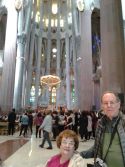
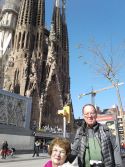 Indeed, the Sagrada Familia, a modern basilica, is one of those buildings so iconic that when you see it, you know you are in Barcelona. Started by Antoni Gaudi nearly 150 years ago, it’s still unfinished, and new architects (12 I understand) are attempting to complete the building, which is Spain’s most visited monument. That’s a good thing, because it’s funded solely by tour money and requires about $2 million a month in maintenance and development.
Indeed, the Sagrada Familia, a modern basilica, is one of those buildings so iconic that when you see it, you know you are in Barcelona. Started by Antoni Gaudi nearly 150 years ago, it’s still unfinished, and new architects (12 I understand) are attempting to complete the building, which is Spain’s most visited monument. That’s a good thing, because it’s funded solely by tour money and requires about $2 million a month in maintenance and development.

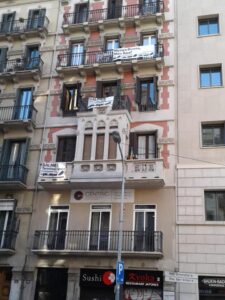 Gaudi never liked straight lines, and it’s interesting to see what he did to some apartment buildings around the city—the Catalan contribution to modernism. One looks like caves (he admired Catholic hermits), with a crowning mountain on top.
Gaudi never liked straight lines, and it’s interesting to see what he did to some apartment buildings around the city—the Catalan contribution to modernism. One looks like caves (he admired Catholic hermits), with a crowning mountain on top.
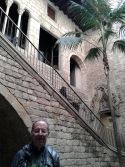
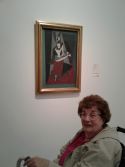 The Picasso museum houses mostly works from his younger years, when his father (a painter) tried his best to convince his son if he wanted to make a living he would have to learn portraiture. While some of the portraits border on “classic,” Picasso soon moved into blue and cubism, the kind of work that’s mostly in museums elsewhere. Guernica, the only piece Carolyn likes, is in Madrid.
The Picasso museum houses mostly works from his younger years, when his father (a painter) tried his best to convince his son if he wanted to make a living he would have to learn portraiture. While some of the portraits border on “classic,” Picasso soon moved into blue and cubism, the kind of work that’s mostly in museums elsewhere. Guernica, the only piece Carolyn likes, is in Madrid.
I, on the other hand, enjoyed the museum itself—a well put together five renaissance palaces—the best room for me being the one left from the old palace, but I’ve been known to prefer baroque to Braque.
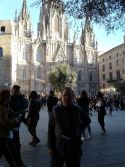
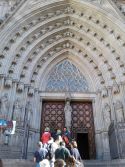 I also enjoyed my tour of the old city. I had to visit the Cathedral, started around 1300 and finished 150 years later, with a neo-Gothic façade added in the late 19th century. The side chapels were all either 1400 or late 17th century, either Renaissance or Baroque, stunning tributes to the wealth of medieval Barcelona.
I also enjoyed my tour of the old city. I had to visit the Cathedral, started around 1300 and finished 150 years later, with a neo-Gothic façade added in the late 19th century. The side chapels were all either 1400 or late 17th century, either Renaissance or Baroque, stunning tributes to the wealth of medieval Barcelona.
Once the home of the Kings of Aragon, Barcelona’s history dates from Octavius Augustus, to whom a temple still stands. In fact, under the palace of the king, part of the building has been excavated as one of the most interesting Roman ruins I’ve seen. What is uncovered is the industrial heart of the Roman city (1-4 centuries), including a fish sauce factory, a winery, and, my favorite, a laundry. I learned that one of the “cleansing agents” was urine, which the laundry collected outside its doors in pots for the purpose. The company paid a tax to be able to gather the precious ingredient, which turned to ammonia. Carolyn doubted my theory about how I could help her with laundry!
That building, part of the palace of the King, also traced the history of religious spots on the site, from Augustus who was treated as a god, through the introduction of Christianity (a la Constantine, who in 313 declared Christianity the official religion. It came too late to save Euliala, a martyr in 303 whose body lies under the present Cathedral); then came the subsequent occupation by the Christian Visigoths, the Muslims (for about 80 years), then the Counts of Barcelona and finally the splendid Cathedral .
The treat today was to have been the impressive National Museum of Catalan Art, which houses a collection of medieval art rescued from churches about to be demolished. Alas, it being Sunday, the museum closed early, so we contented ourselves with a three-hour tour on the On-Off bus, which took us past another shrine in the city—FCB, the football stadium of Barcelona, home of Lionel Messi and lots of people who think football is played with your foot.
The real treat was the discovery that at 11 this morning the symphony was doing Beethoven’s 9th symphony. What a novel idea—brunch with Beethoven. The unusual feature was as simultaneous performance art of people and slides. The highlight, of course, is the final movement, the setting of Schiller’s Ode to Joy, which is the unofficial anthem of the European Union—the statement of the ‘Other” Europe, that all men are brothers, including Castilians and Catalans.